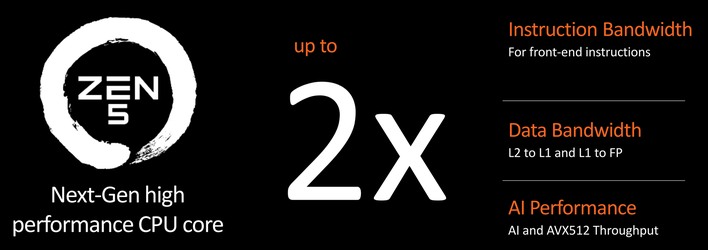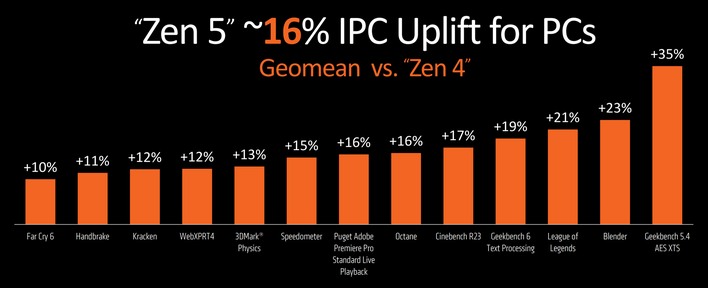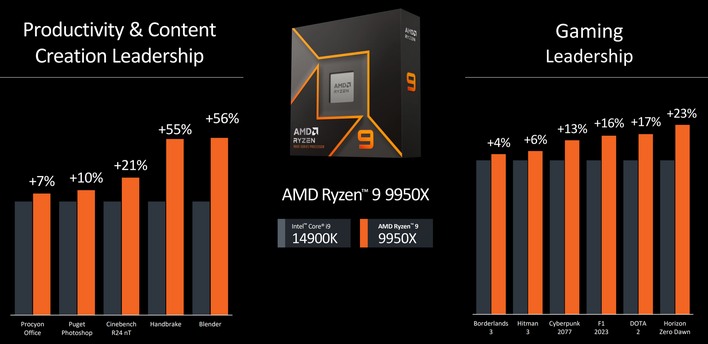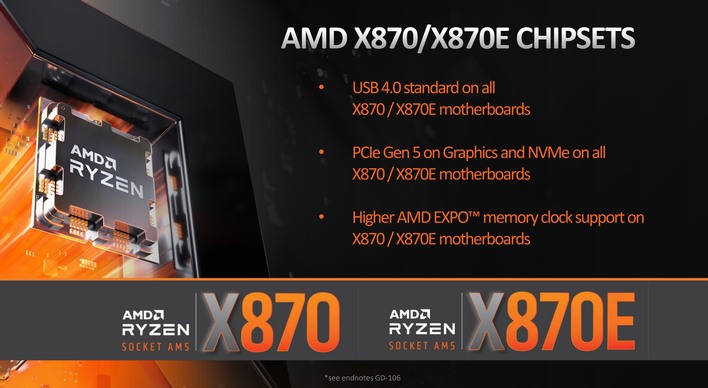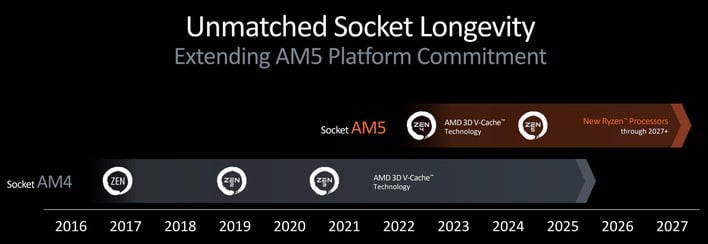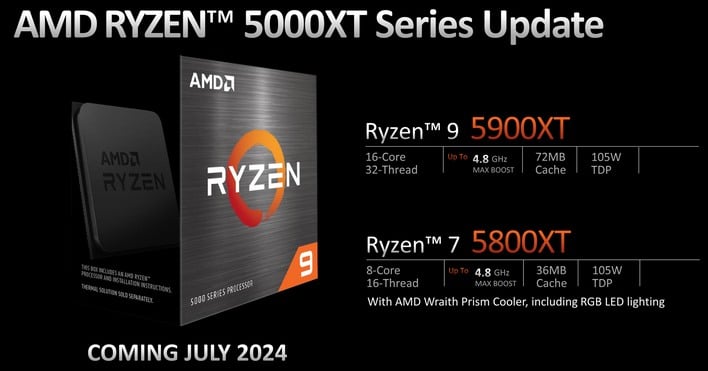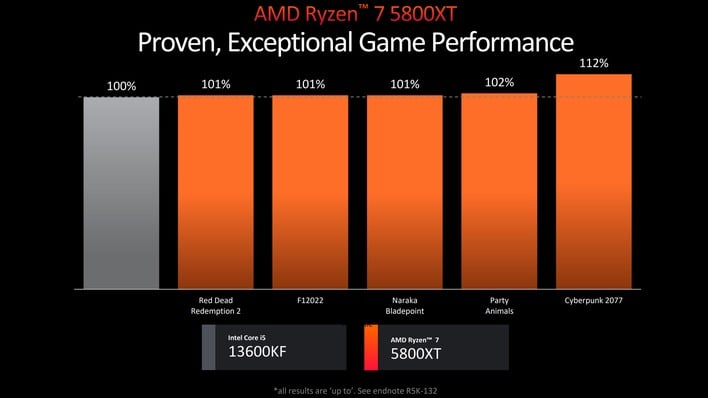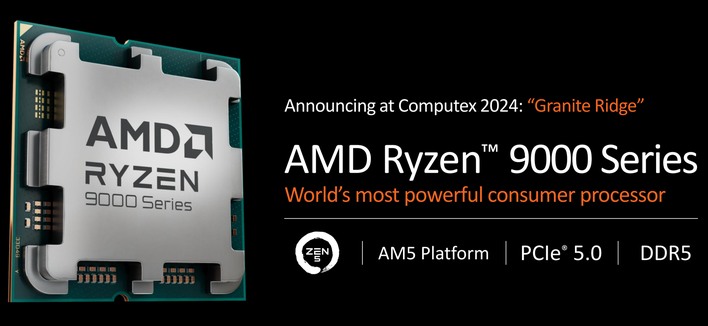AMD Ryzen 9000 Desktop CPUs Bring Efficient Zen 5 Performance To Socket AM5
We say that in the most positive way possible, mind you. Announced this morning at Computex Taipei, Ryzen 9000 desktop processors, code-named "Granite Ridge," look a whole lot like the Ryzen 7000 family, and we mean that both figuratively—in terms of specifications—and literally: they look nearly identical, externally. There's a huge difference under the hood, though, and that's the fully-reworked Zen 5 CPU core.
What Makes The AMD Ryzen 9000 Series Tick?
We'll go at this backwards, so first, let's look at the models. Ranging from the six-core Ryzen 5 9600X up to the sixteen-core Ryzen 9 9950X, this CPU family probably looks very familiar. Even the clock rates haven't changed much; the Ryzen 5 9600X and the Ryzen 7 9700X get an extra 100 MHz of boost clock over their previous-gen predecessors, but otherwise, the core counts, clock rates, and cache capacities are all unchanged.What has changed are the TDPs. Only the top-end Ryzen 9 9950X comes with a full 170W TDP. The Ryzen 9 9900X steps down to just 120W, while the single-CCD models both come in as 65W processors. This is thanks to both the higher efficiency of the Zen 5 core and also the shift to more advanced 5nm fabrication. AMD says that it is quite happy with the out-of-the-box performance of these parts, but that, of course, you can still enable PBO and ramp the power consumption as high as they'll go.
So, what about that Zen 5 CPU core? AMD didn't go into detailed technical specifics; that will probably have to wait for Hot Chips. However, we do know that Zen 5 is overall a wider and deeper design than Zen 4. It has the usual generational improvements in branch prediction accuracy and latency, but it also doubles the width of the SIMDs, radically improving vector throughput.
AMD says that Zen 5 can achieve double the performance of Zen 4 in specific areas, including the front-end instruction fetch/decode hardware, the bandwidth inside the processor core from L2 to L1 and then to the FPUs, and the aforementioned double-wide AVX units, allowing for much better AI performance than on Zen 4.
Indeed, what you won't find on the Ryzen 9000 processors is an NPU. AMD explained that this is due to a combination of factors. If you want the low-latency response time offered by CPUs, Zen 5 gives great throughput there, while if you're doing heavyweight AI workloads on a desktop, you're probably going to run them on a discrete GPU. Adding an NPU would largely be wasted silicon, AMD reasons, so there isn't one here.
Compared to Zen 4, AMD reports an average IPC gain of 16% for Zen 5. That's a pretty darn solid generational improvement, and some tasks will see even greater gains thanks to the earlier-mentioned uplifts in specific hardware. A 15% boost in Speedometer translates directly to an immediately-noticeable improvement in the responsiveness of web applications, which is great news for the modern web.
AMD Ryzen 9000 Series Expected Performance
AMD didn't shy away from direct comparisons against Intel's finest. The Core i9-14900K is a monster CPU, yet AMD claims complete dominance over Intel's 253W, 24-core behemoth, with commanding leads in tasks like Handbrake and Blender. The gaming results are somewhat less impressive, but an extra 13% in Cyberpunk 2077 is nothing to sneeze at.
Tellingly, AMD made absolutely no mention whatsoever of 3D V-Cache in this presentation, which implies to us that Ryzen 9000 CPUs are probably not any faster than Zen 4 X3D in gaming. It's going to depend heavily on the game, of course, but rumors are that AMD will announce Zen 5 X3D at CES, so if you're rocking a Ryzen 7 7800X3D, you can feel good about your purchase for a while longer.
AMD also didn't say a peep about the graphics integrated into the Ryzen 9000 family. In fact, the company didn't even confirm that they will come with integrated graphics at all. However, we have heard previously that the Ryzen 9000 family will use the same cIOD as the Ryzen 7000 series, which means that they should include the same one-WGP RDNA 2 integrated GPU found on those parts.
New 800 Series Chipsets For Socket AM5 Are Inbound
Along with the new CPUs, AMD will also be launching a new set of chipsets, but don't be confused -- Ryzen 7000 and 8000 processors will work fine in the new boards, and the Ryzen 9000 CPUs should slot right into any old Socket AM5 board as long as you have the relevant BIOS update.
X870/E appears to use the same hardware as the extant X670/E motherboards, but it guarantees support for both USB 4.0 and PCIe 5.0 on all models. That extends to the primary graphics slot as well as at least one NVMe M.2 socket. AMD also vaguely states that X870 boards will support "higher AMD EXPO memory clocks," but didn't provide any specifics on how that's achieved beyond "lessons learned with the 600 series."
In what might be the most interesting announcement that AMD made to some of you, it extended its commitment to the AM5 platform through at least 2027, and maybe even longer. The company says that it has enjoyed the consumer response to Socket AM4's longevity, and that it hopes Socket AM5 can enjoy a similar run. We're coming up on eight years of Socket AM4, yet AMD is stil releasing processors for it. In fact, there's two new ones to talk about today.
Yep, the Ryzen 5000XT series are on the way in July, and could make awesome upgrades for folks who already have Socket AM4 machines with older CPUs. It wouldn't be a terrible thing to get every AM4 user upgraded to a Zen 3 CPU. The most notable thing about these parts is that the Ryzen 9 5900XT, despite being called "5900XT", is in fact a 16-core CPU, not a 12-core CPU like the Ryzen 9 5900X.
Otherwise, the Ryzen 7 5800XT gains 100 MHz over the regular 5800X, while the Ryzen 9 5900XT drops 100 MHz of max boost from the Ryzen 9 5950X, but will probably still offer excellent performance in most applications.
AMD compares the Ryzen 7 5800XT against Intel's Core i5-13600KF in a few games and notes that it achieves parity or outperforms in a majority of titles. It's worth noting that both systems in this case were tested with DDR4 memory running at 3200 MT/s, which isn't exactly an optimal configuration for the Raptor Lake CPU, but nonetheless it's not like Zen 3 is slow at this point.
While the first Zen 5 desktop processors might not seem to stray too far from their predecessors, AMD promises exceptional performance and efficiency gains from these CPUs. The fact that they slot into existing motherboards and can roundly outpace CPUs with twice the power consumption (at least, going by AMD's numbers) is very impressive. Look forward to our review once we get our hands on the parts, likely closer to their launch in July.



